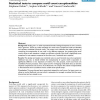2345 search results - page 11 / 469 » Comparing sequence scaffolds |
ITS
2004
Springer
14 years 25 days ago
2004
Springer
Abstract. Betty’s Brain is a teachable agent system in the domain of river ecosystems that combines learning by teaching and self-regulation strategies to promote deep learning a...
DESIRE
2010
13 years 2 months ago
2010
The field of interaction design encompasses a variety of methods for fostering innovation and creativity. In this paper, we present a selection of such methods that scaffold ideat...
BMCBI
2007
13 years 7 months ago
2007
Background: Finding over- or under-represented motifs in biological sequences is now a common task in genomics. Thanks to p-value calculation for motif counts, exceptional motifs ...
BMCBI
2006
13 years 7 months ago
2006
Background: Automatic annotation of sequenced eukaryotic genomes integrates a combination of methodologies such as ab-initio methods and alignment of homologous genes and/or prote...
BMCBI
2005
13 years 7 months ago
2005
Background: The sequencing of the human genome has enabled us to access a comprehensive list of genes (both experimental and predicted) for further analysis. While a majority of t...


